A halo nevus, also called a halo mole, refers to a normal mole but with a white ring, or halo around it.
Halo nevi are not an uncommon phenomenon. About 1% of individuals with fair skin have this. They are usually found in healthy children or young adults, but can also be seen in an older population.
Halos can often be associated with vitiligo which is classified as a more generalized pigment loss. Halo naevi may be linked with another autoimmune disease.
The cause of halo nevi is not known yet. Currently, they are classified as autoimmune in origin.
In some cases, the appearance of halo nevus may be triggered by local trauma or sunburn. The immune system recognizes the mole as something foreign, it then gets attacked by circulating antibodies and CD8+ T lymphocytes. This reaction also affects the normal skin around the mole and causes depigmentation.
The presence of halo nevi can also be associated with psychosocial stress.
These skin lesions are mostly found on the trunk. Head and limbs are less common sites. The affected nevi are classified as dermal nevi which are either congenital or have appeared during childhood.
The white halo is usually in the range between 0.5 and 1.0 cm in diameter and is symmetrical.
There are four stages of a halo nevus. It may take a few years to complete an entire cycle. Stage 1 involves the presence of a rim of pale skin surrounding a mole. During stage 2, the mole may become less pigmented or pinker; it can also start fading away. During stage 3, a circular or oval area of depigmentation arises. During the last stage, the affected skin gradually returns back to its normal colour.
Halo nevus is a clinical diagnosis. Dermatoscopy is commonly used for evaluating nevus’ colour and structure.
A full skin examination should be performed, especially in the adult population. This is because in rare cases halo nevi can be caused by the presence of melanoma on other body sites.
No treatment is normally needed for a typical halo nevus. The white skin of a halo nevi will easily burn under the sun’s exposure because it does not have a protective melanin pigment. It is recommended to cover halo nevi or apply sunscreen on it during sun exposure in order to prevent getting any sunburns.
Surgery is not necessary; however, it may be highly recommended if it has any atypical features like irregular structure.
Centre for Medical and Surgical Dermatology offers unique and personalized halo nevi treatment options for each patient.
One Comment
Comments are closed.
Related Posts




Very interesting post. Your own web site is swiftly turning out to be certainly one of my favorites